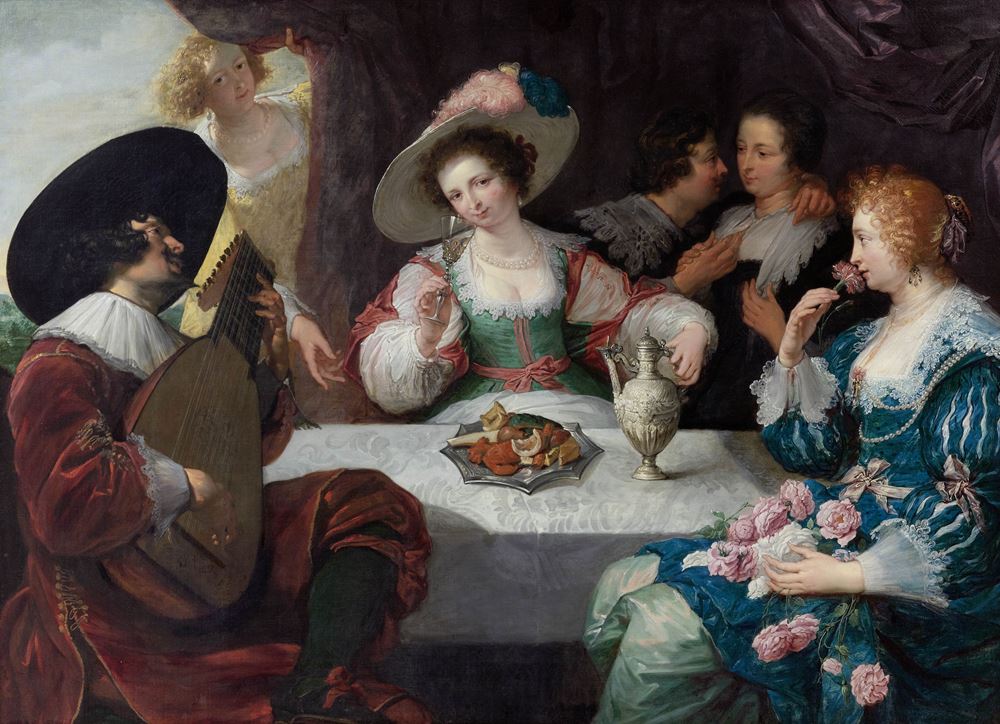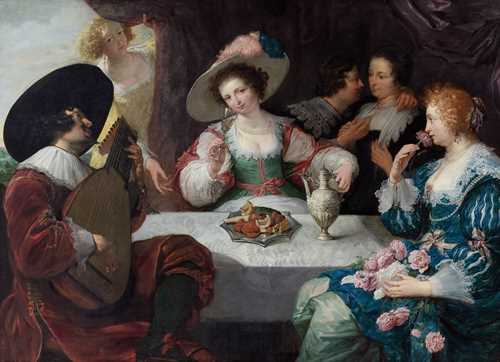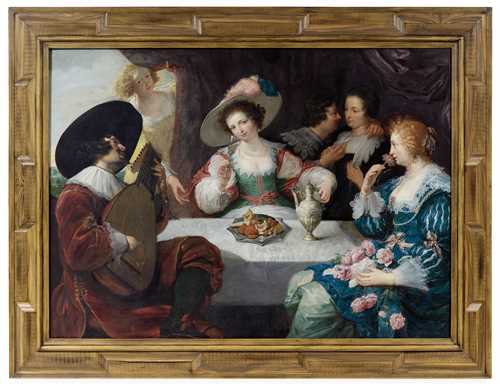
拍品 3045* - A204 大师画作 - Freitag, 31. März 2023, 02.00 PM
JAN COSSIERS
(1600 Antwerp 1671)
Allegory of the five senses: an elegant company seated at a table. Circa 1640.
Oil on canvas.
113 × 155.5 cm.
Provenance:
- European private collection.
- Sale Christie's, London, 13.3.1987, lot 106.
- With Richard Green Gallery, London, until 1995.
- Private collection, USA.
- European collection.
Exhibited:
Boston/Toledo 1993/1994, The Age of Rubens, Museum of Fine Art Boston, 22.9.1993–2.1.1994 / Toledo Museum of Art, 2.2.1993–24.4.1994, no. 62.
Literature:
Exh. cat. The Age of Rubens, ed. by Peter Sutton, New York 1993, pp. 402–405, cat. no. 62.
In this magnificent allegory, the Antwerp painter Jan Cossiers entices us into the world of the five senses. In the centre of the picture sits a young woman dressed in red and green, holding a glass of white wine to her lips while she fixes the viewer with her gaze: she embodies the sense of taste. On the right in the foreground, a woman lifts a carnation to her nose to symbolise the sense of smell. Hearing is represented by the man playing a lute in the foreground to the left. The couple embracing in the background to the right symbolise the sense of touch, and finally the standing woman looking at the viewer from behind the curtain represents the sense of sight.
Since antiquity, the five senses have been understood as man’s access to the world around him. In classical thought, sense perception was also the starting point for the theory of the four elements. In the Middle Ages, the senses acquired a moralising dimension, as it was considered a vice to succumb to sensuous temptations. In the 17th century, however, the preoccupation with those negative connotations dwindled in favour of a more empirical interest in the knowledge gained through sensory experience. The five senses enjoyed especial popularity in Dutch art of the 16th and 17th centuries. Following a series of engravings by Hendrick Goltzius (1558–1617) showing each of the five senses in contemporary dress (c. 1595/96), the Dutch tradition of fusing allegories of the senses with everyday genre scenes was established, and the idea flourished in the Southern Netherlands in the 17th century in works by David Teniers (1610–1690), Joos van Craesbeeck (1605–1661), Simon de Vos (1603–1676) and Theodor Rombouts (1597–1637).
Marjorie E. Wieseman dates this painting to around 1640 (see literature), after Cossiers’ return from Italy, when he worked closely with Peter Paul Rubens (1577–1640) in Antwerp. Among other things, he worked with Rubens on the decorations for the triumphal entry of the Cardinal-Infante Ferdinand of Spain into Antwerp and for the hunting lodge Torre de la Parada of Philip IV of Spain. His later works, although very freely painted, lack the dazzling colourfulness of earlier works, as this allegory offered here impressively demonstrates.
The half-length figures and deep chiaroscuro of Cossiers’ genre scenes are clearly indebted to Caravaggio (1571–1610), whose work he was able to see during his stay in Rome in 1624, although this influence is expressed in a very personal way. His history paintings are more complex and reflect a variety of stylistic influences throughout his career, including that of the Flemish Caravaggists Theodor Rombouts and Gerard Seghers (1591–1651).
Jan Cossiers trained first with his father Anton Cossiers and later with Cornelis de Vos (1585–1651), before spending some time in Aix-en-Provence with Abraham de Vries (1590–1650). He joined the Antwerp Guild of St Luke in 1628/29 and was appointed Dean of the Guild in 1640. The guild's records mention a number of pupils who worked in his studio between 1632/33 and 1666/67. Through his marriage to Jeanne Darragon (d. 1639) and later to Maria van der Willigen, Cossiers acquired considerable wealth and owned several houses in Antwerp.
- European private collection.
- Sale Christie's, London, 13.3.1987, lot 106.
- With Richard Green Gallery, London, until 1995.
- Private collection, USA.
- European collection.
Exhibited:
Boston/Toledo 1993/1994, The Age of Rubens, Museum of Fine Art Boston, 22.9.1993–2.1.1994 / Toledo Museum of Art, 2.2.1993–24.4.1994, no. 62.
Literature:
Exh. cat. The Age of Rubens, ed. by Peter Sutton, New York 1993, pp. 402–405, cat. no. 62.
In this magnificent allegory, the Antwerp painter Jan Cossiers entices us into the world of the five senses. In the centre of the picture sits a young woman dressed in red and green, holding a glass of white wine to her lips while she fixes the viewer with her gaze: she embodies the sense of taste. On the right in the foreground, a woman lifts a carnation to her nose to symbolise the sense of smell. Hearing is represented by the man playing a lute in the foreground to the left. The couple embracing in the background to the right symbolise the sense of touch, and finally the standing woman looking at the viewer from behind the curtain represents the sense of sight.
Since antiquity, the five senses have been understood as man’s access to the world around him. In classical thought, sense perception was also the starting point for the theory of the four elements. In the Middle Ages, the senses acquired a moralising dimension, as it was considered a vice to succumb to sensuous temptations. In the 17th century, however, the preoccupation with those negative connotations dwindled in favour of a more empirical interest in the knowledge gained through sensory experience. The five senses enjoyed especial popularity in Dutch art of the 16th and 17th centuries. Following a series of engravings by Hendrick Goltzius (1558–1617) showing each of the five senses in contemporary dress (c. 1595/96), the Dutch tradition of fusing allegories of the senses with everyday genre scenes was established, and the idea flourished in the Southern Netherlands in the 17th century in works by David Teniers (1610–1690), Joos van Craesbeeck (1605–1661), Simon de Vos (1603–1676) and Theodor Rombouts (1597–1637).
Marjorie E. Wieseman dates this painting to around 1640 (see literature), after Cossiers’ return from Italy, when he worked closely with Peter Paul Rubens (1577–1640) in Antwerp. Among other things, he worked with Rubens on the decorations for the triumphal entry of the Cardinal-Infante Ferdinand of Spain into Antwerp and for the hunting lodge Torre de la Parada of Philip IV of Spain. His later works, although very freely painted, lack the dazzling colourfulness of earlier works, as this allegory offered here impressively demonstrates.
The half-length figures and deep chiaroscuro of Cossiers’ genre scenes are clearly indebted to Caravaggio (1571–1610), whose work he was able to see during his stay in Rome in 1624, although this influence is expressed in a very personal way. His history paintings are more complex and reflect a variety of stylistic influences throughout his career, including that of the Flemish Caravaggists Theodor Rombouts and Gerard Seghers (1591–1651).
Jan Cossiers trained first with his father Anton Cossiers and later with Cornelis de Vos (1585–1651), before spending some time in Aix-en-Provence with Abraham de Vries (1590–1650). He joined the Antwerp Guild of St Luke in 1628/29 and was appointed Dean of the Guild in 1640. The guild's records mention a number of pupils who worked in his studio between 1632/33 and 1666/67. Through his marriage to Jeanne Darragon (d. 1639) and later to Maria van der Willigen, Cossiers acquired considerable wealth and owned several houses in Antwerp.
CHF 400 000 / 600 000 | (€ 412 370 / 618 560)
以瑞士法郎銷售 CHF 439 500 (包含買家佣金)
所有信息随时可能更改。


